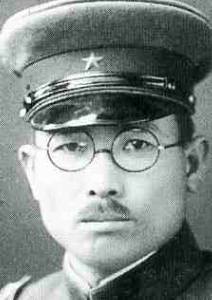Isamu Chō facts for kids
Quick facts for kids
Isamu Chō
|
|
|---|---|
 |
|
| Born | 19 January 1895 Fukuoka, Japan |
| Died | 22 June 1945 (aged 50) Okinawa, Japan |
| Allegiance | |
| Service/ |
|
| Years of service | 1913–1945 |
| Rank | |
| Commands held | 10th Infantry Division |
| Battles/wars | Second Sino-Japanese War World War II |
Isamu Chō (長 勇, Chō Isamu, 19 January 1895 – 22 June 1945) was an officer in the Imperial Japanese Army known for his support of ultranationalist politics and involvement in a number of attempted coup d'états in pre-World War II Japan.
Biography
Chō was a native of Fukuoka prefecture. He graduated from the Imperial Japanese Army Academy in 1913 and from the Army Staff College in 1928.
After he received his commission, Chō was assigned to his first duty outside Japan with the politicized Kwantung Army based in eastern China. He returned to play a very active role in internal politics within the Japanese army, and was an active or indirect participant in the March Incident and the Imperial Colors Incident (with other leaders: Kingoro Hashimoto, Jirō Minami, Sadao Araki for the military, and nationalists Ikki Kita, Shūmei Ōkawa, Mitsuru Toyama, Kanichiro Kamei and Kozaburo Tachibana). He was a founder of the radical "Sakurakai" secret society, whose aim was to overthrow the democratic government in favor of a totalitarian regime which would stamp out corruption. Chō was known to be quick to anger and often struck his subordinates.
At the start of the Second Sino-Japanese War, Chō was commander of the IJA 74th Infantry Regiment of the Shanghai Expeditionary Force, attached to Japanese Central China Area Army, and based in Manchukuo. At the Battle of Nanjing, he was aide-de-camp to Prince Asaka and is thought to have been complicit in ordering the Nanjing Massacre, but it is disputed whether he obeyed an order from the prince, or whether he acted on his own.
Chō was subsequently involved in a number of border incidents between Manchukuo and the Soviet Union as Chief of Staff of the IJA 26th Division from 1939 to 1940. In 1940 he was transferred briefly to the Taiwan Army of Japan Headquarters, and then became Chief of Staff of the Indochina Expeditionary Army from 1940 to 1941.
Chō was Vice Chief of Staff of Unit 82 within the Military Affairs Bureau, in the Ministry of War in 1941, and participated in the strategic and tactical planning for the Japanese invasion of Southeast Asia.
From 1942 until 1944 Chō was commander of the 10th Infantry Group (Dai 10 Hohei-Dan(第10歩兵団)) of the IJA 10th Division, a garrison force based in Manchukuo. He served in the Kwantung Army Headquarters, and later as commander of the 1st Mobile Brigade. In late 1944, Chō was recalled from Manchuria to the Home Islands, then to Okinawa.
He was Chief of Staff of the 32nd Army during the Battle of Okinawa. He masterminded the elaborate underground fortifications around Shuri Castle, but favored a highly aggressive response to the American invasion rather than a passive defense. He persuaded General Mitsuru Ushijima to launch the disastrous 5 May 1945 counteroffensive.
By the middle of June, the 32nd Army was effectively reduced to occupying two strongpoints, one beneath Kunishi Ridge and the other, the command headquarters inside Hill 89.
Cho’s personal driver, Houhei Arakaki who was former local bus driver/shop owner was dismissed after the 32nd Army moved to the southern part of Okinawa. Arakaki was reunited with his family and escaped to the south but shot to death by an American soldier on 26 June. Arakaki was 40 years old.
Chō died on 22 June 1945.
On the back of Cho's kimono was a poem that he had composed:
“With bravery I served my nation.
With loyalty I dedicate my life.”

